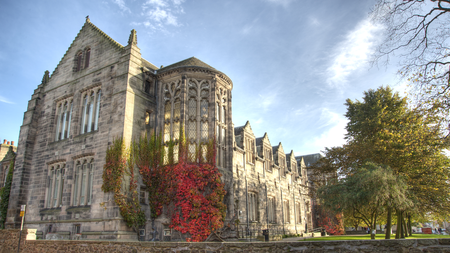
Lecturer
- About
-
- Email Address
- thomas.vogwill@abdn.ac.uk
- Telephone Number
- +44 (0)1224 273250
- School/Department
- School of Biological Sciences
Biography
I am an evolutionary biologist and microbiologist. My lab researches both the rapid microevolutionary processes of microbes as well as the bigger scale, macroevolutionary processes such as microbial speciation. In previous positions I have worked on a range of different aspects of microbial evolution, including herbicide resistance, bacteriophage evolution, and bacterial biogeography.
Timeline
February 2020 – present: Aberdeen, School of Biological Sciences
September 2015 – January 2020: Imperial College London, Silwood Park
January 2012 - September 2015: Oxford University, Department of Zoology
September 2009 – December 2011: University of Warwick, Warwick HRI
October 2006 – September 2009: University of Liverpool, Department of Biological Sciences
- Research
-
Research Areas

Biological and Environmental Sciences
Research Specialisms
- Ecology
- Microbiology
- Evolution
- Genomics
Our research specialisms are based on the Higher Education Classification of Subjects (HECoS) which is HESA open data, published under the Creative Commons Attribution 4.0 International licence.
- Teaching
-
Courses
- Publications
-
Page 1 of 1 Results 1 to 16 of 16
Identifying and exploiting genes that potentiate the evolution of antibiotic resistance
Nature Ecology & Evolution, vol. 2, pp. 1033-1039Contributions to Journals: Articles- [ONLINE] DOI: https://doi.org/10.1038/s41559-018-0547-x
- [ONLINE] View publication in Scopus
- [ONLINE] Oxford University Research Archive
Divergent evolution peaks under intermediate population bottlenecks during bacterial experimental evolution
Proceedings of the Royal Society of London. B, Biological Sciences, vol. 283, no. 1835, 20160749Contributions to Journals: ArticlesPersistence and resistance as complementary bacterial adaptations to antibiotics
Journal of Evolutionary Biology, vol. 29, no. 6, pp. 1223-1233Contributions to Journals: ArticlesEpistasis between antibiotic resistance mutations and genetic background shape the fitness effect of resistance across species of Pseudomonas
Proceedings of the Royal Society of London. B, Biological Sciences, vol. 283, no. 1830, pp. 1-8Contributions to Journals: ArticlesThe genetic basis of the fitness costs of antimicrobial resistance :: a meta-analysis approach
Evolutionary Applications, vol. 8, no. 3, pp. 284-295Contributions to Journals: Articles- [ONLINE] DOI: https://doi.org/10.1111/eva.12202
- [OPEN ACCESS] http://aura.abdn.ac.uk/bitstream/2164/13954/1/Vogwill_etal_eva_The_genetic_basis_VOR.pdf
- [ONLINE] View publication in Scopus
Limits to compensatory adaptation and the persistence of antibiotic resistance in pathogenic bacteria
Evolution, Medicine and Public Health, vol. 2015, no. 1, pp. 4-12Contributions to Journals: Articles- [ONLINE] DOI: https://doi.org/10.1093/emph/eou032
- [OPEN ACCESS] http://aura.abdn.ac.uk/bitstream/2164/13952/1/MacLean_etal_EMPH_Limits_to_VOR.pdf
- [ONLINE] View publication in Scopus
Testing the Role of Genetic Background in Parallel Evolution Using the Comparative Experimental Evolution of Antibiotic Resistance
Molecular Biology and Evolution, vol. 31, no. 12, pp. 3314-3323Contributions to Journals: ArticlesHerbicide mixtures at high doses slow the evolution of resistance in experimentally evolving populations of Chlamydomonas reinhardtii
New Phytologist, vol. 198, no. 3, pp. 938-945Contributions to Journals: Articles- [ONLINE] DOI: https://doi.org/10.1111/nph.12195
Herbicide cycling has diverse effects on evolution of resistance in Chlamydomonas reinhardtii.
Evolutionary Applications, vol. 6, no. 2, pp. 197-206Contributions to Journals: Articles- [ONLINE] DOI: https://doi.org/10.1111/j.1752-4571.2012.00276.x
- [ONLINE] http://europepmc.org/abstract/med/23467494
The experimental evolution of herbicide resistance in Chlamydomonas reinhardtii results in a positive correlation between fitness in the presence and absence of herbicides.
Journal of Evolutionary Biology, vol. 25, no. 10, pp. 1955-1964Contributions to Journals: Articles- [ONLINE] DOI: https://doi.org/10.1111/j.1420-9101.2012.02558.x
- [ONLINE] http://europepmc.org/abstract/med/22913345
Coevolving parasites enhance the diversity-decreasing effect of dispersal
Biology Letters, vol. 7, no. 4, pp. 578-580Contributions to Journals: Articles- [ONLINE] DOI: https://doi.org/10.1098/rsbl.2011.0071
How does spatial dispersal network affect the evolution of parasite local adaptation?
Evolution, vol. 64, no. 6, pp. 1795-1801Contributions to Journals: Articles- [ONLINE] DOI: https://doi.org/10.1111/j.1558-5646.2009.00937.x
- [ONLINE] http://europepmc.org/abstract/med/20050909
Antagonistic coevolution accelerates molecular evolution
Nature, vol. 464, no. 7286, pp. 275-U154Contributions to Journals: Articles- [ONLINE] DOI: https://doi.org/10.1038/nature08798
Dispersal and natural enemies interact to drive spatial synchrony and decrease stability in patchy populations.
Ecology Letters, vol. 12, no. 11, pp. 1194-1200Contributions to Journals: Articles- [ONLINE] DOI: https://doi.org/10.1111/j.1461-0248.2009.01374.x
- [ONLINE] http://europepmc.org/abstract/med/19719839
Source populations act as coevolutionary pacemakers in experimental selection mosaics containing hotspots and coldspots.
The American Naturalist, vol. 173, no. 5Contributions to Journals: Articles- [ONLINE] DOI: https://doi.org/10.1086/597374
- [ONLINE] http://europepmc.org/abstract/med/19272015
The impact of parasite dispersal on antagonistic host-parasite coevolution.
Journal of Evolutionary Biology, vol. 21, no. 5, pp. 1252-1258Contributions to Journals: Articles- [ONLINE] DOI: https://doi.org/10.1111/j.1420-9101.2008.01574.x
- [ONLINE] http://europepmc.org/abstract/med/18631211
